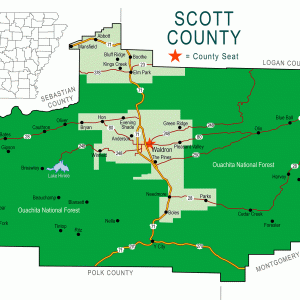calsfoundation@cals.org
Bryan (Scott County)
Bryan is an unincorporated community located in northwestern Scott County along Highway 28 north of the Poteau River. The community of Bryan was also known as Center Point and Bryan’s Spur. Agriculture has traditionally been important to the area.
Prior to European exploration, Bryan was a wilderness lush with native vegetation and numerous species of wildlife—including buffalo and elk, which no longer inhabit the area. Archaeological evidence from the Archaic, Woodland, and Mississippian periods has been discovered throughout the area. Additional evidence has indicated that the Caddo tribe had a strong presence along the Poteau River and other prominent waterways.
Throughout the late seventeenth and early eighteenth centuries, French trappers and explorers traveled west from the Arkansas Post along the Arkansas River. From there, they began traversing smaller tributaries such as the Fourche La Fave River and Poteau River. It is likely that they traveled through the area where Bryan is now located. There are also unsubstantiated stories of Spanish exploration in the western portion of Scott County.
White settlers began arriving in the area near Bryan as early as the late 1820s. The area continued to be settled from the 1830s to the 1920s. Most early families participated in a wide variety of agricultural practices.
In 1851, the Sebastian County line extended farther south into a portion of Scott County. The line was eventually changed, adding a large farming area to Scott County west of Bryan.
The Civil War affected people living in the area near Bryan as it did throughout the rest of the Confederacy. Men who were called to fight in the war served with both the Confederacy and Union. Additionally, the women, children, and elderly were left to look after the homes and farms. After the war, there was a large migration of families to western Scott County. Some of the first families to move to Bryan after the war were the Plummers, Caseys, Helms, Gibsons, Presleys, and Halls.
After Reconstruction, Bryan became a more established community. Even though the area was known as Bryan, it was also commonly referred to as Center Point. Center Point Cemetery was established circa 1890s. The Center Point School was also established sometime after Reconstruction. One of the first school houses was located at the east end of the ridge that begins near the cemetery. In May 1882, the Scott County Courthouse burned, destroying all records that defined the boundaries of the various school districts that had been established throughout the county. In August, the county court reestablished the boundaries of the fifty-six school districts active in the county, including Center Point School District (Number 46). When the community became more populated, the school house was moved to the west end of the ridge in order to be more centrally located. Several years later, a new school house was built south of the old school house near the cemetery. It was torn down, and a two-room school house was built in its place; however, it eventually burned down.
In 1901, the Arkansas Western Railroad, a subsidiary of the Kansas City Southern (KCS), built a 31.7-mile line east from Heavener, Oklahoma, to Waldron (Scott County) in order to service the coal and timber industries. Bryan was one of the communities located along the route. The name Bryan’s Spur originated from the spur of the railroad that went through the area.
The Bryan post office was established in May 1915, with Christopher Richmond as the first postmaster; however, it was discontinued in October. The mail was then sent to the Hon (Scott County) post office.
Several members of the Bryan community served during World War II. After the war, Bryan began to decline significantly, especially with the loss of its school. The Center Point School District was consolidated with Waldron sometime between 1949 and 1953.
Today, the area where Bryan is located is commonly referred to as Center Point. There is little to no infrastructure remaining in Bryan; however, the steps from the old Plummer house and a well that was located near the school remain. Agriculture continues to be an important practice in the area, mainly in the form of cattle and chicken farms. Hunting and fishing are popular recreational activities among residents.
For additional information:
Biographical and Historical Memoirs of Western Arkansas. Chicago: Goodspeed Publishing Company, 1891.
Cate, Michael. History of Scott County, Arkansas. Dallas: Curtis Media Corporation, 1991.
Goodner, Norman. A History of Scott County, Arkansas. Siloam Springs, AR: Bar D Press, 1941.
McCutcheon, Henry Grady. History of Scott County, Arkansas. Little Rock: H. G. Pugh and Company, 1922.
Ty Richardson
Richardson Preservation Consulting
 Scott County Map
Scott County Map 



Comments
No comments on this entry yet.